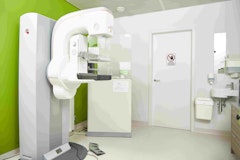Mammography
Mammography remains the standard examination
in detecting breast cancer
A mammography has a high sensitivity in detecting abnormalities, with a low number of 'false positive' results. This sensitivity is further enhanced if the images can be compared with previous images. It is therefore important to bring these images if they have not been performed in MCH.

Tomosynthesis
With tomosynthesis, it is possible to highlight the breast in a 3-dimensional image. This is done in exactly the same way as an ordinary mammography, but the compression of the breast takes a little longer each time in order to scan the breast at an angle of 50°. Afterwards, a reconstruction of the images is done, giving a 3D image. The radiologist can then view more individual details in the mammary gland tissue.
Screening mammography
A screening mammography (completely free if you have a Belgian national registry number) is possible from 1 January of the year you turn 50, until 31 December of the year you turn 69. The mammography is done in exactly the same way as a classic mammogram. No ultrasound can then be done on the same day. Two to three weeks afterwards, both your doctor and you will be informed of the result.
Breast ultrasound
Depending on the density of the mammary gland tissue, and on the findings on the mammography, a further ultrasound is performed afterwards. Ultrasound can increase the chance of detecting (small) lesions that were initially not or not clearly retained on mammography in moderate and high density breast gland tissue. In low-density breast glandular tissue, there is no need to perform ultrasound.
Practical guidelines and tips
- A mammography is always done by appointment
- Do not forget your application form
- Bring your previous examinations with you on the day of the examination if they were not carried out in MCH
- It is best to have a mammogram at the beginning of the cycle (the first 14 days following your period), mainly because your breasts are the least sensitive then and the mammogram is also easier to assess
- Because you have to completely uncover your upper body during the examination, it is easier to wear separate clothing (i.e. trousers or skirts instead of a dress or pantsuit)
- Preferably do not use deodorant, ointment, body lotion or powder. These can cause interference on the images. Perfume is not a problem.
